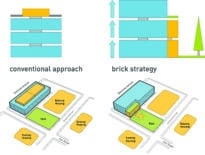
Modular housing containing micro-units can fit on vacant lots in urban areas and provide social service agencies with the opportunity to create low-cost permanent housing for previously homeless individuals. Image courtesy of Margulies Perruzzi
“Housing First” is a proven strategy in the nationwide fight to solve the seemingly intractable problem of homelessness. People are assisted to locate housing first, without preconditions around compliance, and then are engaged to address other issues in their lives once they have the stability of a home.
For “Housing First” to work, however, there must be a sufficient stock of housing for people with very low incomes. Though the causes of homelessness are myriad, one of the major propellants has been gentrification of low-cost housing and the virtual elimination of “flophouses” – places where those in need of shelter could stay inexpensively without long-term commitment.
While many individuals who are homeless long term may have disabling conditions such as mental health issues or substance use disorder, the overarching issue for all people experiencing homelessness is they do not have adequate financial resources to afford housing. It is almost impossible to provide support for them with stabilizing their lives if they do not have a safe, affordable and respectful place to live.
A Modern Successor to Triple-Deckers
Enter the concept of modular micro-housing units in the program that the Massachusetts Housing & Shelter Alliance (MHSA) calls “A Place to Live.” Working with a variety of agencies, most notably the South Middlesex Opportunity Council in Worcester, MHSA has advocated for the construction of buildings of 18 to 24 units that are purpose-built for adults who are homeless or at-risk of homelessness.
The “A Place to Live” building looks much like traditional triple-deckers or the contextual architectural equivalent. These small, efficient buildings can fit onto vacant lots available throughout urban areas, allowing new residents to become reintegrated into their neighborhoods close to public transportation, near support services and convenient to shopping and education.
These micro-units, usually about 250 square feet, can be designed to meet all current code and accessibility requirements of the municipal, state and federal funding agencies. The best part for residents is the units are full-size studios with a kitchenette, private bathroom and sleeping space – the kind of spaces that people with lived experiences of homelessness say they prefer over old-style rooming houses. The buildings also contain spaces for private and group counseling, common laundry and bike storage facilities.
Comparative cost analysis of modular versus traditional construction clearly shows that for this type of project, the modular approach costs 30 percent less and takes half as much time to build.

Marc Margulies
Overcoming Hurdles to Construction
Modular micro-units are becoming more common elsewhere in the U.S. and around the world. Given the clear case for them, why haven’t we seen a proliferation of these micro-units around Massachusetts? There are several reasons that point to challenges to be overcome:
Zoning policies for multifamily residential buildings almost always require providing a large number of parking spaces, which drives up the cost and limits the use of available land for housing. As few of the target homeless residents have cars, and the sites are selected for their adjacency to public transportation, the parking requirement becomes an unnecessary burden.
Public funding agencies are challenged to approve non-traditional procurement processes. Collaboration with modular manufacturers is essential to these projects; each factory has its own technologies and systems that allow it to be most efficient. These partnerships with manufacturers need to be put in place early, often before funds are awarded. The old “Design-Bid-Build” approach is not the best way to take advantage of modern or innovative modular construction processes.

Joe Finn
Purchasing land for the construction of housing for people who are homeless is fraught with challenges. The timeframe for securing an agreement to buy the land, applying for and receiving funding, obtaining neighborhood approval (or surviving neighborhood opposition), and finally closing on the purchase of the land often takes years. Few property owners want to sell their land to an agency that may or may not be able to close for several years. Clearly, we need a better way to identify and obtain ownership of appropriate sites than battling restrictive land-use barriers and a tight real estate development market.
Homelessness has become a national crisis, and we have a moral imperative to come up with solutions. Modular micro-units are one solution that meets this urgent need and makes economic sense. Let’s address the barriers in order to create such housing now. There is a place for everyone to participate and support the “A Place to Live” concept to help our most needy neighbors without housing.
Marc Margulies is a principal and senior partner at architectural and interior design firm Margulies Perruzzi and Joe Finn is president and executive director of the Massachusetts Housing & Shelter Alliance.






